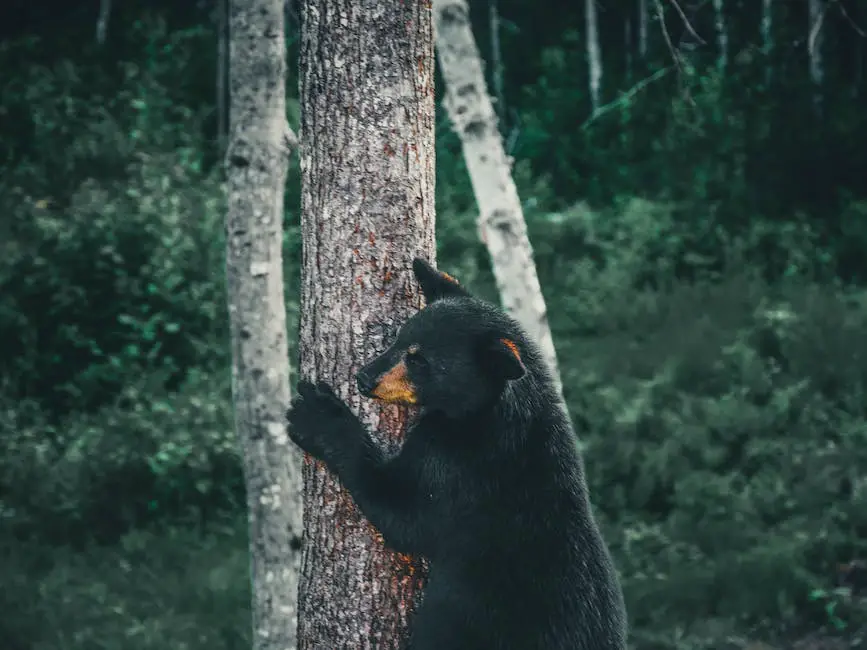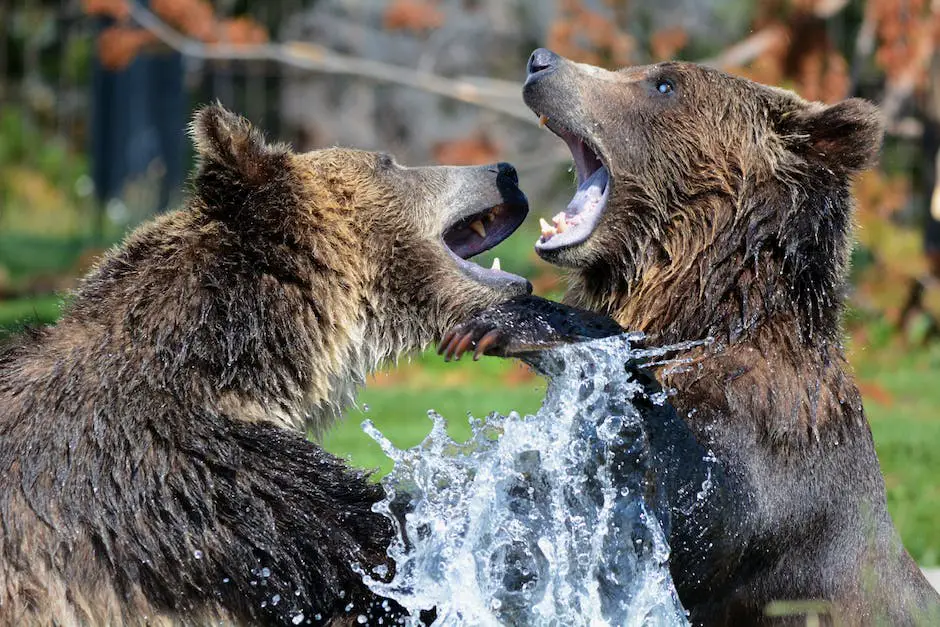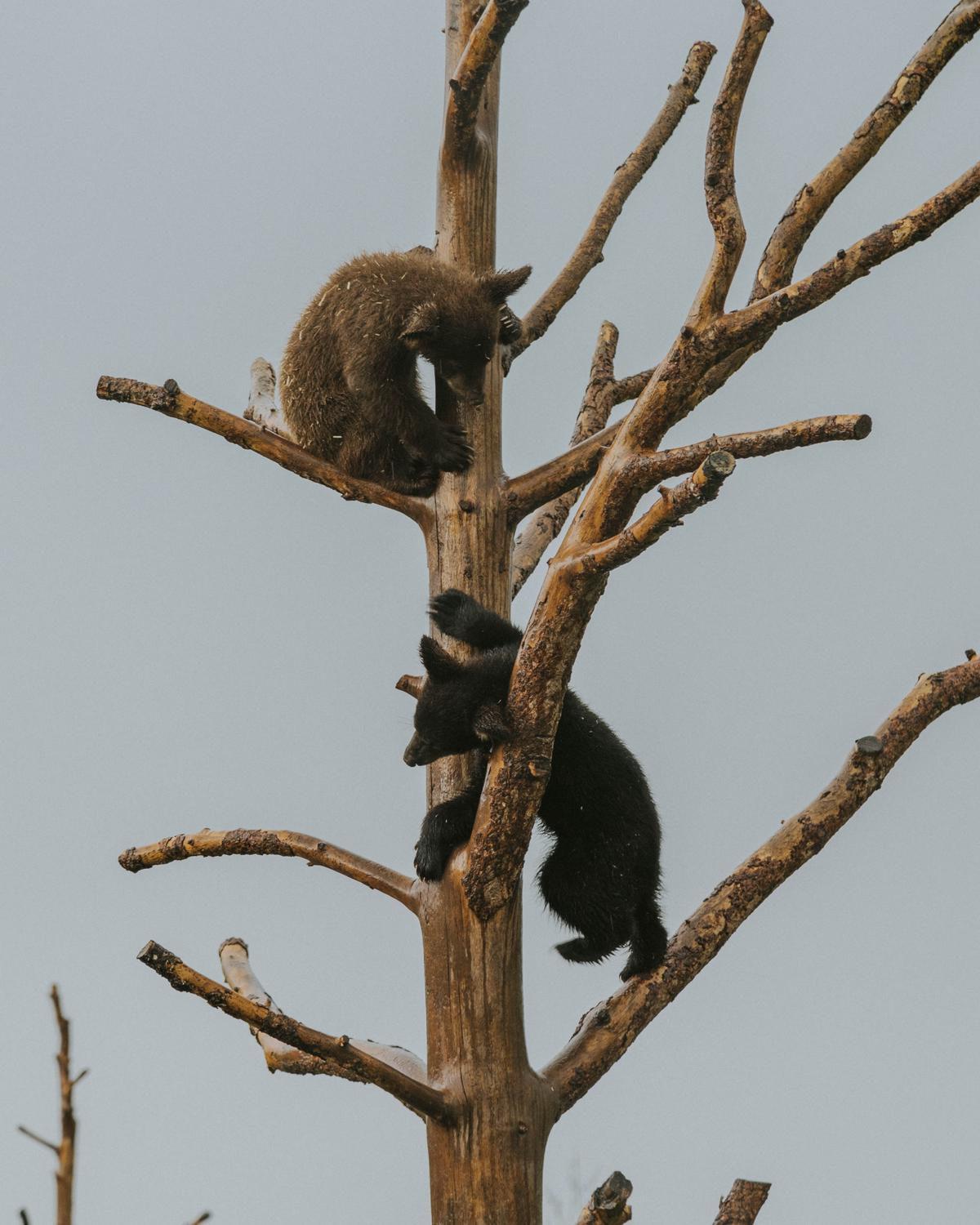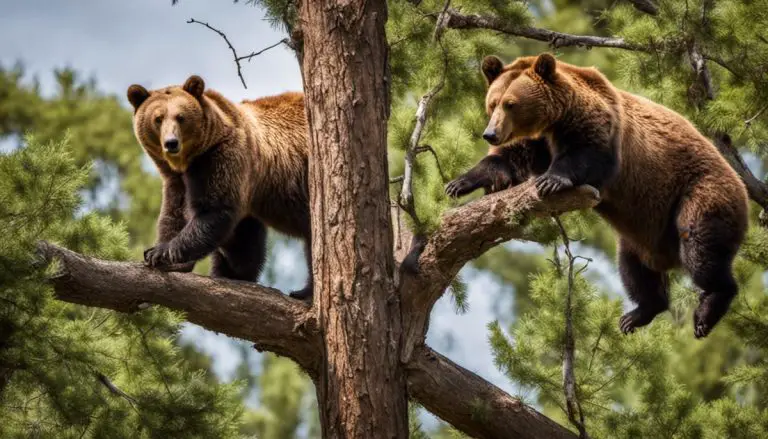In the world we inhabit, one filled with diverse and compelling creatures, bears hold a distinctive place. These giant yet often misunderstood mammals are renowned as great runners and swimmers, but few would consider them skilled arborists. However, a number of bear species have an astonishing attribute – they climb trees. But which species possess this unusual trait and why use such energy-intensive agility at all? Going beyond the conventional understanding, we delve into the realm of tree-climbing bears, exploring their physical attributes, reasons behind this behavior, lifestyle implications and the contemporary threats they face along with the concerted global efforts to conserve them.
Species of Bears that Climb Trees
American Black Bears: Expert Tree Climbers
American Black bears are a dominant bear species that are known to climb trees with relative ease. This species has a small, compact build, generally weighing between 200 and 600 pounds, with males usually being larger than females. They possess sharp claws and close-set eyes which assist them in their arboreal activities. American Black bears predominantly live in forested areas, where they leverage their climbing skill to escape possible threats, receive a cooler breeze on hot days, and access food such as honey from beehives. They have an omnivorous diet that includes berries, plants, insects, fish, and small mammals. Their lifespan generally ranges from 25 to 30 years in the wild.
Asian Black Bears: The Tree Housekeepers
Asian Black bears, often referred to as Moon bears due to the white crescent-shaped mark on their chest, are another species known for their tree-climbing prowess. They are similar in size to the American Black bear, tipping the scales at 220 to 440 pounds. They have muscular bodies with large paws, long claws, and fur that is generally darker and thicker than their American counterparts. Asian Black bears inhabit forested regions in Asia, with a prominent preference for hilly or mountainous areas. Their diet consists of fruits, nuts, insects, small mammals, and occasionally, carrion. They seek refuge in trees for resting and also hibernate in burrows during the colder months. The typical life expectancy of an Asian Black bear is about 30 years in captivity and 25 years in the wild.
Sun Bears: Smallest Yet Skillful Climbers
Sun bears are the smallest species of bears, weighing between 60 and 150 pounds, but their small size does not hinder their tree-climbing abilities. They possess a short, sleek black or dark-brown coat, and, like the Asian Black bears, have a distinct mark on their chest, but which resembles the sun. Sun bears have long tongues, powerful jaws, and large, curved claws for tearing into termite hives and bee nests, or fruits in trees. Found in tropical rainforest habitats of Southeast Asia, their diet comprises primarily insects, larvae, honey, fruit, and occasionally vertebrates. Sun bears are reported to have a lifespan of approximately 25 years in captivity, with no precise data available for those in the wild.
Grizzly Bears: Occasional Tree Climbers
Though not as adept at tree climbing as their smaller counterparts, Grizzly bears can and do climb trees, especially when they are young and weigh less. Adult Grizzlies can weigh between 400 and 800 pounds, with some exceptionally large males exceeding 1,000 pounds. They possess a robust build, with a hump of muscle mass over their shoulders, long, sharp claws and a powerful bite force, primarily used for digging and hunting. They dwell in diverse habitats, such as forests, prairies, and meadows in the North American region. Grizzlies are omnivores, as they eat a wide variety of food, including fish, berries, roots, insects, and small and large mammals. In the wild, they live up to approximately 25 years.
Introducing the Tree-Climbing Spectacled Bears
Spectacled bears, known in some circles as Andean bears, are notable for their unique cream or white markings that circle their eyes, giving the appearance of wearing spectacles. These bears have a solid build with sturdy limbs and short, but broad snouts. They weigh between 220 and 400 pounds and are the only species of bear that’s native to South America. Their habitats range from shrubby deserts to cloudy Andean forests. What truly sets these bears apart is their exceptional tree-climbing abilities. They spend a significant amount of time in trees, where they create comfy platforms for feeding, resting, or even storing food. Mostly herbivorous, these bears feast on plants and fruits, occasionally grabbing a quick bite of meat. When living in the wild, spectacled bears can live up to 20 years.

Reasons Behind the Climbing Habit
Tree Climbing: A Unique Survival Strategy Among Bears
Typically known for their terrestrial habits that involve hunting, foraging, and everyday survival, certain species of bears introduce an intriguing twist to these behaviors. They are proficient climbers, frequently ascending trees for various purposes. This adaptation plays a critical role in their survival, serving various needs such as evading potential predators, pursuing prey, acquiring hard-to-reach sustenance, and finding a restful perch for a snooze. This combination of ground-dwelling behaviors and tree-climbing capabilities offer a unique look into the diverse survival strategies of these mesmerizing creatures.
Evasion of Predators
One of the prime reasons why bears climb trees is to evade potential threats. As apex predators, adult bears have little to fear from most wildlife. Yet, this isn’t true for bear cubs, which make an easy prey for larger predators. In these situations, tree-climbing becomes a lifeline allowing them to retreat to safety in the branches, away from potential dangers on the ground. Tree climbing also offers adult bears an escape route from larger bears or human threats.
Hunting and Food Gathering
Tree climbing also plays a fundamental part in the hunting and foraging habits of some bear species. The Sun bear, native to the tropical rainforests of Southeast Asia, is a notable example. It regularly climbs trees to access honey from honeybee nests, its preferred food source. Similarly, the American black bear, a known climber, exploits arboreal habitats for berries, nuts, and insects. By accessing the vertical space, these bears increase their dietary spectrum, enhancing their survival chances.
Resting and Vigilance
In addition to survival and food acquisition, trees are crucial resting areas for certain bear species. This is especially true in hot climatic conditions, where bears can retreat to the lower temperatures found in higher altitudes, preserving crucial body energy. The often-dense tree canopy also provides shade and protection against harsh weather conditions.
Moreover, by resting in trees, bears gain a vantage point for potential threats or available resources in their surrounding environment. This factor of heightened vigilance further contributes to their survival.
Bear Livelihood and the Role of Tree Climbing
Tree climbing serves as an integral part of the lifestyle of certain bear species, like the brown bear and black bear. It is deeply intertwined with their daily routines, offering benefits in predator evasion, resource gathering, and habitat safety. The study of these behaviors is essential not just for enhancing our understanding of these species, but also for their conservation, considering the multitude of ways they utilize their habitats.

Impact of Tree Climbing on Bear Behavior and Lifestyle
The Significance of Tree Climbing in Bear Mating Rituals
The skill of climbing trees is also a strategic factor in the mating rituals of bears. Targeting taller trees, male bears use these heights to broadcast their scent across a broader area, a signal to potential mates about their presence and robustness. This technique maximizes their chances of finding a companion. Female bears, conversely, use tree climbing as defensive behavior against aggressive mates, reaching safe heights to avoid confrontations and potential harm.
Hibernation and Tree Climbing
A bear’s ability to climb trees significantly impacts its hibernation habits, primarily through the selection of safe and secure hibernation sites. Some bears choose hollowed-out trees as their hibernation spots, while others may erect dens near the base of large trees. Trees provide protection from predators and harsh weather conditions during the months-long hibernation period. Additionally, climbing bears often utilize branches as platforms for sunbathing, which allows them to warm up after the cold winter months before coming out of hibernation.
Tree Climbing and Social Interactions
In bear society, tree climbing plays a significant role in various forms of social interactions. For example, cubs are taught to climb trees as a defensive mechanism against potential threats. This early introduction to tree climbing also helps younger bears establish and understand their boundaries within the bear population. When conflicts arise over food or territory, tree climbing offers an avenue for less dominant bears to escape confrontations.
Bears, Tree Climbing, and Their Role in the Ecosystem
Bears that climb trees have a unique place in their ecosystems. Many of the tree types they climb, such as oak and hickory trees, benefit from the bears’ feeding habits. As the bears forage for nuts, they not only feed themselves but also contribute to seed dispersal, facilitating the growth and spread of these trees. This inadvertent planting positively impacts the woodland ecosystem, creating more habitats for various species and promoting biodiversity.
Furthermore, by occasionally preying on tree-dwelling animals, these bears help control the population of certain species, maintaining balanced and healthy ecosystems. However, it’s worth noting that this trait could also lead to conflicts with humans, especially in areas where bears and people cohabit.
Tree Climbing: A Key Survival Strategy For Bears
Tree climbing is a crucial survival technique employed by various species of bears. This strategy provides them with a safe spot to avoid predators, helps them reach sources of food located outdoors, and creates an ideal lookout point to spot possible threats or prey. Over time, evolution has gifted bears with robust forearm and shoulder muscles, which are instrumental in helping them climb. This adaptability, relatively rare among larger mammals, epitomizes the vital role of tree climbing in ensuring bears thrive as a species.

Threats to Tree-Climbing Bears and Conservation Efforts
Pitfalls Encountered By Tree-Climbing Bears
Tree-climbing bears worldwide are confronting a range of threats that destabilize their habitats and jeopardize their survival. A significant threat includes deforestation, driven by a rampant rise in illegal forestry practices and conversion of forests for agriculture, urbanization, and infrastructure growth. This encroachment strips bears of their habitats, causing not just the loss of their safe homes, but also leading to a severe dip in food and shelter resources, which complicates their survival in their native habitats.
In addition to deforestation, climate change poses a substantial risk to these tree-climbing species. Changes in temperature and rainfall patterns have direct ramifications on the ecosystems where these bears live. Habitat-destroying occurrences like droughts, floods, and wildfires brought on by climate change lead to food shortages. American black bears are a notable example of a species heavily reliant on seasonally available foods, making them particularly susceptible to fluctuating weather conditions.
Similarly, human activities, including hunting and poaching, are significant threats to the survival of these bear species. Sport hunting and illegal trading—often fueled by demand for bear fur, fat, and bile in traditional medicine—greatly deplete bear populations. For species such as the Andean bear, human conflict is triggered by livestock predation and crop raiding, resulting in these usually elusive creatures becoming targets of violence.
Bears also face danger from vehicle collisions, especially in areas where human developments encroach on wildlife habitats. This human-induced mortality contributes to a gradual yet continuous decline in bear populations – a circumstance gravely felt in groups with already dwindling numbers and slow reproductive rates.
Conservation Efforts to Protect Tree-Climbing Bears
Conservation efforts worldwide aim to mitigate these threats and ensure the survival of tree-climbing bears. Broadly, the initiatives focus on habitat conservation, policy implementation, education and outreach, and scientific research.
Protected areas have been established to safeguard the habitats of many bear species, providing them with a safe territory to feed, breed and roam freely. For example, the American black bear has 12 subspecies, some of which reside in national parks stretching from the Appalachians to the Rockies. Similarly, in South America, protected areas exist for Andean bears in countries such as Ecuador and Colombia.
Policy and regulations have also played an essential role in the conservation of these magnificent creatures. Laws like the Endangered Species Act in the United States make it illegal to hunt, harass, or kill any endangered or threatened species, providing necessary protection to the Louisiana black bear and grizzly bear, among others.
Education and raising awareness about these bears, their importance in ecosystems, and their threats, play a significant role in conservation efforts. It encourages responsible social attitudes and behaviors towards these animals, leading to reduced conflicts and increased nationwide support for their preservation.
Lastly, scientific research initiatives contribute significantly to bear conservation. Through the study of bear behavior, genetics, population dynamics, and evolution, scientists can understand their needs better, identify threats early, and propose informed conservation strategies. Significant research initiatives such as the Smithsonian Andean Bear Conservation Program are making strides in understanding bear behavior and implementing effective conservation strategies.
In conclusion, the threats to tree-climbing bears are severe and multifaceted, arising from both environmental changes and human activities. However, with ongoing efforts in conservation, policy implementation, public engagement and scientific research, there is hope for the protection and preservation of these majestic creatures and their habitats.

Photo by connerbaker on Unsplash
Tree-climbing bears remind us of nature’s astonishing ability to adapt to challenges, a testament of survival and a captivating spectacle of the wild. However, the survival saga of these creatures is increasingly grim, jeopardized by rampant deforestation, climate change and human interruption. It is now more crucial than ever that humanity recognizes its role in these threats and commits to resilient conservation initiatives. As we strive to protect these magnificent creatures and their habitats, we concurrently preserve the fascinating mystery of our ecosystem, allowing future generations an entrée into the mesmerizing world of tree-climbing bears.





